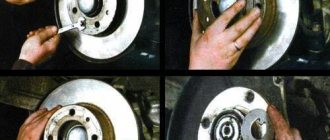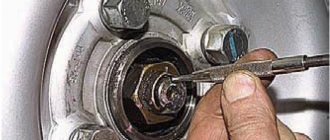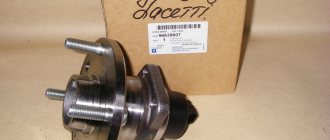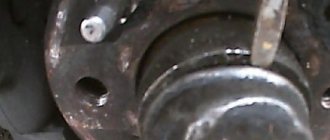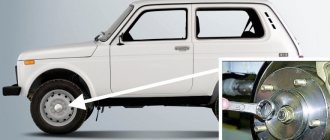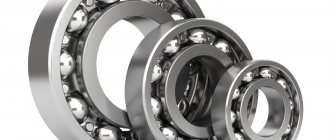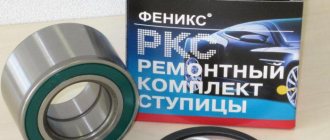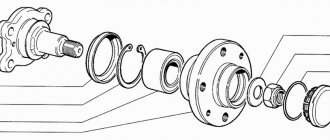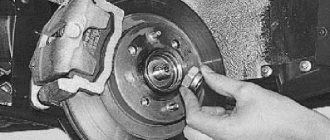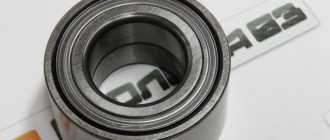On Niva, wheel bearings are two tapered bearings (on each hub, i.e. there are four in total), the tension of which is ensured by a wheel nut, which is tightened with a certain torque. When tightening, it is necessary to control the runout of the brake disc using a micrometer... but this is wise! But in fact, almost all motorists, and even more so “servicemen,” tighten it like this: spin the wheel (brake disc), tighten the hub nut, tighten it... tighten it... and so on until a given moment (at best). As a result, quick bearing failure! In addition, this operation has to be carried out when replacing a CV joint or simply after a strong side impact on the wheel, for example on a high curb. It was decided to replace the package of Nivov bearings with a double-row front wheel bearing of the Moskvich 2141 (No. 2141-3103020), as I learned, this bearing is also installed on some foreign cars. The overall dimensions of the bearing (37*72*37) allow it to be installed in the Niva’s front hubs, subject to some “alterations”. It is necessary to slightly reduce the landing diameter of the hub itself to 37 mm. And bore the steering knuckle! This is the most difficult process because... requires coordinate grinding (to make an ideal seat for a new bearing). You can, of course, get by with a simple lathe and a good turner (it will be MUCH cheaper!), but I decided not to skimp on quality and turned to professionals in this matter, who, in turn, made all the parts I needed for a “tidy” sum. You also need special support washers with a thickness of 10.5 mm.
Now a little more about all this: We remove and completely disassemble the old hubs, clean everything from dirt. We go to the bearing store and buy the double-row bearing No. 2141-3103020 we need or its imported equivalent in the amount of 2 pieces. Personally, I bought American bearings from the “Craft” company, number: CR4172370, if I’m not mistaken. We will also need two retaining rings from the front wheel bearings of the Moskvich-2141 car (No. 366553-15), they can be of different thicknesses, so we be sure to buy them in advance. If you have chosen the cheap option, then we take the drawings and go to the turner and spend a long, long time persuading him to take on this task... Then we carefully monitor the quality of the work. After everything is ready, we try to press in the bearing and begin assembling. If you choose the expensive option, contact some organization related to high-precision machining, explain the situation, give them all the parts (bearings, retaining rings) and go home, wait for the result. Personally, I turned to a turner and for a certain amount of money they sharpened the hubs to fit new bearings, bored (or rather ground) the steering knuckles, made 4 pieces of support washers, at the same time corrected the “jamb” with the neck for the oil seal on one of the hubs, and ground the seats under the brake disc on the hubs, and also pressed new bearings into place and installed retaining rings. Next, having received a set of ready-made parts, we begin to assemble! Because The bearings have their own rubber seal, so there is no need for standard seals. But I still recommend installing them (you can use the cheapest ones), if only to limit the entry of water and dirt into the steering knuckle. We assemble the hub and brake disc. In this case, it is better to take a new brake disc (or an old one, if there is little wear on it!). The fact is that to replace the brake disc on a Niva, you need to remove the hub, and these new bearings can only be pressed out against the inner race - i.e. The bearing will then no longer be suitable for use! Next, we press the hub into the bearing (in the steering knuckle), not forgetting to install the support washers (one between the journal under the oil seal on the hub and the bearing, the second is installed later, on the other side of the bearing, between the bearing and the CV joint.)! We assemble the entire assembly and install it on the car. Now we tighten the hub nut with a large torque (about 200 Nm), as they say: “from the heart”! And from now on we go and enjoy...
Reinforced, non-adjustable hubs
For Niva 4x4 you can find reinforced, non-adjustable hubs with double-row bearings from the Iveco Daily truck. According to the manufacturer, this modernized unit has the following advantages over Nivovsky:
- there is no need to adjust (the bearing tightening is precisely set during its production);
- no need for regular lubrication;
- eliminates rotation of bearings on the hub;
- eliminates wear of bearing seats on the steering knuckle and hub;
- a ball bearing reduces friction in the hub assembly;
- The service life of the hub is increased due to thickening (see photo).
Instructions for installing steering knuckles with non-adjustable bearings are included. To download files you need to log in to the website. There is at least one drawback of such a modified Niva hub - high cost.
Is there an alternative to permanent repairs?
It must be admitted, but the wheel-bearing unit of the Niva 4x4, being one of the most loaded in the car, has never learned to be reliable. Whether the culprit is bad components or design errors is not easy to figure out. However, the experience of the owners suggests using alternative options, for example, replacing the “stock” with double-row bearings (IVECO, Moskvich, etc.).
Unlike the standard:
- The unit does not require adjustment or lubrication - all settings are made from the factory. There is no possibility of rotation; Wear of seats is minimal; Has an extended service life.
The difficulty of implementation lies in the need to bore the hub for a double-row bearing, as well as the relatively high cost of the components. But there will most likely be no short-term attempts to change the wheel bearing again.
Converting the hub to a double-row bearing
Do you want to modify your Niva, but have a small budget? Then we’ll show you how to remake the front hubs on a Niva with your own hands. Required:
- double-row bearing from Moskvich 2141 (catalog number: 2141-3103020), or an analogue from Craft (article: CR4172370);
- two retaining rings from the same vehicle (part number 366553-15).
We take the drawings and seek the services of a turner. The master must bore the hub to fit new bearings, grind the steering knuckles and make parts according to the diagram. By the way, some Niva 4x4 owners also use the AUDI 74x40x74 wheel bearing, in this case only the steering knuckles are ground.
After the parts are manufactured, all that remains is to press in the double-row bearing and reassemble the already non-adjustable hubs. At the end of the work, tighten the hub nut with a large torque “from the heart”. Their adjustment is no longer required, you can forget about the hum and howl while driving!
Have you ever encountered a similar modification to the Niva hub? Leave recommendations and reviews about your options for upgrading the VAZ 2121, 2131. Let us remind you that the domestic SUV has other shortcomings, which are also eliminated by modifications. You can also find information about the car you are interested in by its content.
Key words: Niva front suspension
The content of the article :
“Reinforced” hub unit for Niva with reinforced hub 2123 (24 splines) from VolgaAvtoprom
I purchased this product:
An initial inspection showed the presence of strange holes through which water freely gets to the bearing bypassing the seal...
Holes past the seal
I called the manufacturer to clarify why they were needed, and why the instructions did not say to seal them. To which I was told that these are technological holes for pressing out the inner race from the hub. Then I began to wonder why such tricks were needed. It turned out that the hub shaft with a diameter of 40.03 (personally measured) was made supposedly to prevent the hub race from turning... Although it should be -0.01 ... -0.02 in order to be able to remove the hub without disassembling the bearing.
VolgaAvtoProm has a conditionally dismountable unit (not dismountable) - each time an expensive bearing must be replaced. Because it comes apart and the clip remains on the hub.
Chevrolet Niva Zadornaya Shtuchka › Logbook › another topic about wheel bearings
In my posts under other people’s topics, I expressed an ambivalent opinion about the suitability of standard wheel bearings for long-term use. At the same time, I agree that the node is hemorrhoidal. I’m mentally ready to install Ivekov’s soles, but as a typical Capricorn, I’ll first check my speculations in practice. And they are as follows: our standard bearing can drive a car for a long time and without problems, driving in moderate shit and in urban conditions, provided: 1. alignment of the mounting holes (the replaced bearings have already passed 40-50k); 2. systematic maintenance (at least once a year); 3. with installation through a damper bushing. After reading (without studying) the EPK catalogs (a group that includes several factories, including 15 VPZ, 9 Samara Plant), the technical docs of the 23rd Vologda Plant obtained the following information: the bearing is standard and is produced by almost all factories in Russia under their own brands such as Volzhsky Standard, VBF , VPZ, and all the Chinese, who will pack what. The world industry leaders also do it. Here are its characteristics from the catalog of the Vologda plant.
Installation of double-row roller bearings from the IVEKO Daily truck into the front hubs of Niva 21213
Wheel unit VAZ 21 (21,213,214,218,30…)
one of, I’m not afraid of this word, the most colorful, in terms of purely Russian (obscene) words addressed to him by Nivavodov, an engineering sophistication, and today the managerial stupidity of AvtoTAZ is completely archaic.
When assembling, to adjust the clearance in the bearing according to the book, you need to: “...Install a new adjusting nut. We tighten it to a torque of 19.6 N.m (2.0 kgf.m), simultaneously turning the hub in both directions. Loosen the adjusting nut and tighten it again to a torque of 6.86 N.m (0.7 kgf.m). Then loosen the nut 20–25o. We check the clearance in the bearings: it should be in the range of 0.02–0.08 mm. We lock the nut by pressing its collar into the grooves of the shank of the outer drive joint...” It would be fine if I did it once and forgot, but the need for adjustment often arises, especially if you drive on bad roads. And if you miss the moment a little, the hub will begin to rotate in the inner race of the bearing, and that’s it - the play can no longer be eliminated by simply tightening the nut and I ran to the shops to buy bearings (2 pieces for 250 rubles each), a new hub (750-1000 rubles), and the sellers Thanks to AvtoTAZ engineers, meanwhile, they are happily rubbing their hands.
But okay, if I just went and bought the part I needed in the store, installed it and drove off, but no! After TAZ began installing hubs and grenades with 24 splines in Niva, the production of hubs with 22 splines for spare parts was stopped, like if you need it, then buy external grenades with 24 splines along with the hubs, because rich people drive around in Niva, they There is no problem at all in providing charitable assistance to starving Ketai people. So people are toiling around, buying the devil in stores: Either the diameter of the hub is +/- a kilometer, or the metal is raw meat, or the bearings are like crazy, you’ll understand what kind of fit. In general, again everyone knows parsley with the quality of spare parts for a Russian miracle of engineering.
Once, out of naivety, I bought a new hub and bearings at a car shop. And what did you see? — The new bearing does not fit on the new hub!
Measurements showed: hub diameter 40.01 mm, bearing diameter 39.98 mm?! What the heck? In this case, at the service station, they simply use sandpaper to reduce the diameter of the hub by eye and, if necessary, hammer the bearing onto the hub with a sledgehammer (I’m not lying, I saw it myself). With this approach to the manufacture of parts for cars, Russian vehicles are objects of increased danger to those around them in a cube! Not to mention the fact that this threatens the health and safety of the driver of such a vehicle.
All this parsley persistently drilled into my brain, but finally finished me off and prompted me to take active action.
I've seen enough pictures of the modified unit
I googled drawings for boring a fist,
I ordered the best bearings SKF IVEKO BTH-1024 C (2200 RUR/piece) from a truck with a load capacity of 5.5 tons, such a huge margin of safety. The bearing is a fairy tale:
Nobody will do such things in our Russia, that’s for sure, and if they do, it will be a pathetic parody.
Chevrolet Niva expedition › Logbook › * 6008 wheel bearings (experience)
The experiment with the front hub assembly regarding the installation of a package of two 6008 bearings with a spacer sleeve has come to an end.
Update 0:
After reading the forums about “improving” the front hub assembly, I decided to install 6008 bearings. Sharpening the hub obviously doesn’t suit me, and boring the steering knuckle is a filigree task, so that’s why this path was chosen. Moreover, in case of unsatisfactory performance, you can reassemble everything on the original roller bearing. And so, the low price and the humming original bearing made the decisive move - I ordered such a kit.
In the kit I received two VBF-6008 bearings for each side, a spacer sleeve, two spacer rings, two oil seals and a hub nut.
In the future I plan to replace VBF with SKF and fill it with the “holy” lubricant “Mobilgrease XHP™ 222”, I don’t know when this will be, since there are no complaints about VBF yet, and the lithol-type lubricant is still in place.
I am pleased with the modernization, for now I will continue sea trials.
Update 1:
the first unpleasant moment, the right hub works, the bearings in the left one are crushed. Apparently the consequences of installation without adjusting the spacer sleeve. In principle, this problem was noticeable even during installation, I thought it would get used to it - and in fact it got used to it, just not as expected :). In the near future I plan to reassemble it with adjustment of the bushing.
Update 2:
reassembled the left side. The hub needs to be replaced, SKF bearings, Mobilgrease XHP 222 lubricant. The spacer sleeve was processed with a “file”, as well as the side washers. After assembly and tightening with force, unlike the previous time, the unit turns easily and naturally. We can only hope that the hub is made geometrically correctly, and not as it usually happens here, either the machines are crooked, or the hands grow from somewhere, or the place is like that. And of course I hope that I didn’t mess up anywhere. Let's see how long she can run now.
Update 3:
And it only ran about eight thousand kilometers. The left hub began to move, tightening it did not help. An autopsy showed that two balls on the inner bearing had broken. Moreover, the separator remained intact. The outer bearing had no play, but did jam when rotating. No traces of moisture were found. The most interesting thing is that in this condition I drove for about 150 km and the bearings did not jam or completely fall apart. After such a story with the left side, I returned the roller bearings. Only this time I didn’t look for Ketai raw meat at the auto market, I took the best thing that was in the bearing store - the French bearing SNR 32008C. As is tradition, everything is treated with Mobilgrease XHP™ 222 lubricant.
Source
Installing a new part
Manufacturers do not lubricate their bearings and rings very generously, so you will have to add the missing amount of grease yourself. Litol-24 in an amount of 40 g is suitable; apply lubricant to the separator and rollers before replacing the Niva front hub. Don't forget to adjust the gap. If there is no hydraulic press or puller, we will replace it using a hammer and a mandrel (or using an old ring):
- The outer race is inserted into the hub socket and driven without distortion through a wooden spacer.
- For its final landing, you can take a pipe of a suitable diameter or a mandrel.
- Then a separator is placed inside, and the assembly is assembled using the reverse algorithm.
Where to install
This method of strengthening the front hub will be much more economical than contacting a car service.
The Chevrolet Niva SUV (VAZ 2123) is reliable and, like no other car, is adapted to the realities of road conditions in Russia. Thanks to the arrangement of the hub, wheel bearing, brake drum, and wheel disk, a community of parts is created that can withstand heavy loads. The greatest pressure falls on the wheel bearing; in fact, it holds the entire mass of the car.
The bearing experiences the greatest load during acceleration and braking, which cannot but affect the technical requirements placed on it.
Unfortunately, even on such a car, harsh operating conditions have a sad effect on the components, especially the suspension. That's why sometimes it breaks down.
"Niva Chevrolet": creation and reviews
In general, AvtoVAZ tried to come up with a car to replace the Niva back in the late eighties. It was quite logical that the glory of a new SUV at that time would not last long, and in order not to “lose face,” a replacement was necessary. But at first the project remained only in paper form.
In 1998, a sample of the VAZ-2123 was presented, which was considered “the same replacement.” But until 2002, mass production was not established.
In 2002, the license for this model, and at the same time the Niva brand, were sold to the General Motors concern. The technicians of this company made about a thousand different changes to the appearance and “filling” of the SUV, which allowed the new car to be considered an independent and independent model from now on. In September 2002, a conveyor was launched, from which the Chevrolet Niva began to roll off.
In 2009, the car's design underwent changes.
According to the reviews of those who purchased this car, it was still the same AvtoVAZ, and even attempts to intervene and bring about changes for the better in terms of electronics and design did not bring good results. But, as noted by car owners, this did not affect the off-road qualities - the Niva is still passable in impassable conditions.
